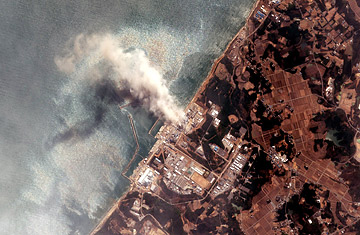
A satellite image shows the Fukushima Dai-ichi Nuclear Power plant after a massive earthquake and subsequent tsunami in Futaba, Japan.
The Nuclear Regulatory Commission is expanding modeling of potential radiation exposures from the stricken Japanese nuclear power plant to track emissions that could spread 7,000 miles from the reactors, far past Tokyo. An NRC spokesman said the commission would, if necessary, recommend that all Americans evacuate Tokyo, located about 135 miles south of the crippled Fukushima Daiichi power complex.
NRC spokesman David McIntyre said the commission would recommend that all Americans get out of Tokyo, a city of 13 million people, "if conditions were to worsen and the wind direction were to change."
Working in 24-hour shifts since the earthquake struck, the commission's Protective Measures Team has established an elaborate model for estimating radiation exposures from the plant. The model consists of four hypothetical reactors meant to simulate each of the four hobbled reactors in Japan. The team then inputs the best available data on potential releases from each of the stricken Japanese reactors and meteorological data from the area.
McIntyre stressed the team does not have precise data on radiation releases from the nuclear complex. "The actual release data, that is where the hypothesis comes in," he stressed. "We are making assumptions there because we don't have exact data on what is coming out of the plant."
The NRC recommends evacuations take place when the model shows that individuals might be exposed to 1 rem of radiation to the body or 5 rems to the thyroid over a 16-hour period. The NRC says the average American is exposed to 0.62 rem of radiation each year from natural and manmade sources.
Dr. John Chute, a cancer biology expert at Duke University Medical Center, says the NRC's evacuation limit levels are equivalent to the radiation exposure from 100 chest x-rays. "That, or above that, can cause some thyroid damage or risk of cancer development down the road," Chute explained. "I think the NRC is doing the right thing here. If this was day after day after day, I'd leave myself."
McIntyre, the NRC spokesman, said the commission's models typically estimate exposures up to 50 miles from a plant and recommend evacuations to that distance once potential exposures exceed the 100-chest-x-ray level. That's what happened yesterday, when NRC Chairman Gregory Jaczko broke with the Japanese, who had recommended evacuations within 12 miles of the plant, and said Americans within 50 miles should leave.
The NRC is now widely expanding its model to try to trace potential exposures, however minute or harmless, across the globe. "Most of our models go up to 50 miles," McIntyre said. "Well, all of a sudden we want to see 7,000 miles, because we want to see where it is going to go, if it is headed toward California."
